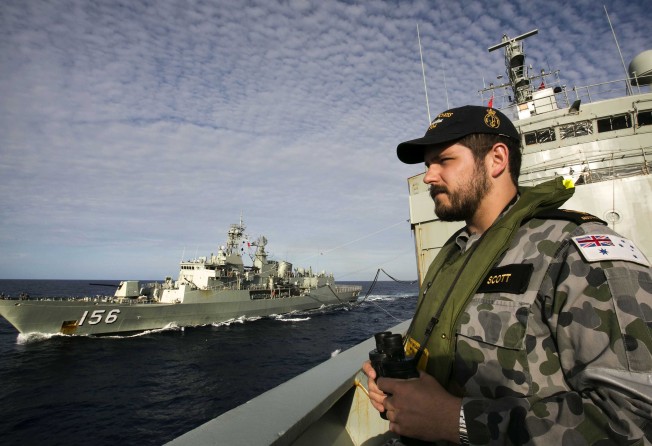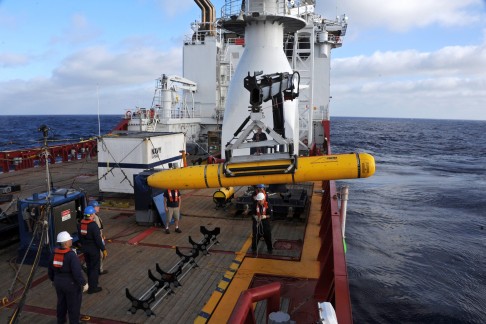Australians examine new leads for links to missing Malaysian Airlines jet
Researchers at Curtin University in Western Australia are conducting analysis on an unusual sound recorded at the time of the disappearance as new witness comes forward

A team of Australian researchers looking into the disappearance of Malaysia Airlines flight 370 released data on Wednesday about an unusual underwater sound recorded around the time the plane vanished, though the lead scientist acknowledged the chances it is linked to the jet are slim.
The low-frequency sound was picked up by underwater listening devices in the Indian Ocean off the west coast of Australia on March 8, the same day the Boeing 777 disappeared on a flight from Kuala Lumpur, Malaysia, to Beijing with 239 people on board. Researchers at Curtin University in Western Australia have been analysing the signal to see if it may be the sound of the plane crashing into the ocean.
But Alec Duncan, who’s heading up the research, said the sound appears to have originated well outside the jet’s projected flight path that officials determined based on satellite and radar data, and is therefore unlikely to have come from the plane.
“It’s one of these situations where you find yourself willing it all to fit together but it really doesn’t,” said Duncan, senior research fellow with Curtin’s Centre for Marine Science and Technology. “I’d love to be able to sit here and say, ‘Yeah, we’ve found this thing and it’s from the plane’ – but the reality is, there’s a lot of things that make noise in the ocean.”
The noise could have come from a natural event, such as a small earthquake, Duncan said. He put the chances of it being linked to Flight 370 at less than 20 per cent.
Soon after the search for the plane moved to the southern Indian Ocean, scientists from Curtin decided to check the data from their underwater acoustic recorders off Rottnest Island, near Perth, to see if they’d picked up anything of interest. The scientists normally use the recorders for environmental research, such as studying whale sounds. This time, however, the data showed a signal that they initially thought might be the aircraft crashing into the ocean – an event that would have produced a low-frequency sound that can travel thousands of kilometres under the right conditions, Duncan said.
The team then checked data from underwater recorders off the southwest tip of Australia that are run by the United Nations’ Comprehensive Nuclear Test Ban Treaty Organisation in Vienna. One of the recorders had picked up a sound consistent with the original signal. That allowed the team to determine which direction the sound came from – though not its precise location.
“It’s now looking as if it’s unlikely to be due to the aircraft because it seems to be too far out into the ocean.”
The scientists then refined the data further and realised the sound originated somewhere south of India – an area well outside the arc of ocean where officials have determined the plane probably crashed.
“It’s now looking as if it’s unlikely to be due to the aircraft because it seems to be too far out into the ocean,” Duncan said, though his team was triple-checking their calculations just to be sure.
In another new lead in the search the Australian Transport Safety Bureau (ATSB), which is leading the search at the request of the Malaysian government, is looking at the claim from a British yachtswoman made this week.
“The ATSB received ... a message from a member of the public, reporting that they had seen what they believed to be a burning aircraft in the sky above the Indian Ocean on the night of the disappearance of MH370,” a spokesman told reporters in an e-mail. “That information has been forwarded to the ATSB’s MH370 Search Strategy Working Group for review.”
The ATSB on Wednesday released a request for tenders for a company to dive even deeper, to depths of up to 6,000 metres.
It said the successful bidder would be engaged as a prime contractor and provide the expertise, equipment and vessels needed to carry out the search for the Boeing 777 from August.
“The successful tenderer will use the data from a bathymetric survey (already under way) to navigate the search zone, which has water depth between 1,000 and 6,000 metres,” it said.
An international team is now determining a search zone of up to 60,000 square kilometres based on where the aircraft last communicated with an Inmarsat satellite.
British yachtswoman Katherine Tee added to speculation about the location of a possible crash site by revealing she saw a glowing plane over the Indian Ocean in March.

The 41-year-old said she told Australian authorities of her sighting of a plane with “what appeared to be a tail of black smoke coming from behind it” while she travelled from Kochi in India to Phuket in Thailand.
“There were two other planes passing higher than it – moving the other way – at that time,” she wrote on sailing site Cruisers Forum, a firm for which she also works.
“I recall thinking that if it was a plane on fire that I was seeing, the other aircraft would report it.”
She said she told no one at the time because she and her husband, who was onboard but asleep, had been having difficulties and had not spoken for about a week.
“And most of all, I wasn’t sure of what I saw,” she said. “I couldn’t believe it myself.”
But after confirming her yacht’s position using GPS data in recent days, she said she knew she was in the “right place at the right time” and told authorities.
The Joint Agency Co-ordination Centre, which is heading up the search effort, said the Australian Transport Safety Bureau has looked at the research and is discussing it with the Curtin team.
“However, Curtin University has concluded, and the ATSB agrees, that the current results are not compatible with the international search team’s analysis of the most likely area where MH370 entered the water,” the agency said in an e-mail.
Despite a massive air and sea search, no trace of flight 370 has been found, three months after it vanished. The search is on hold for two months while new, specialised equipment can be brought in to scour a 700 kilometre by 80 kilometre swath of ocean where officials believe the plane crashed.
